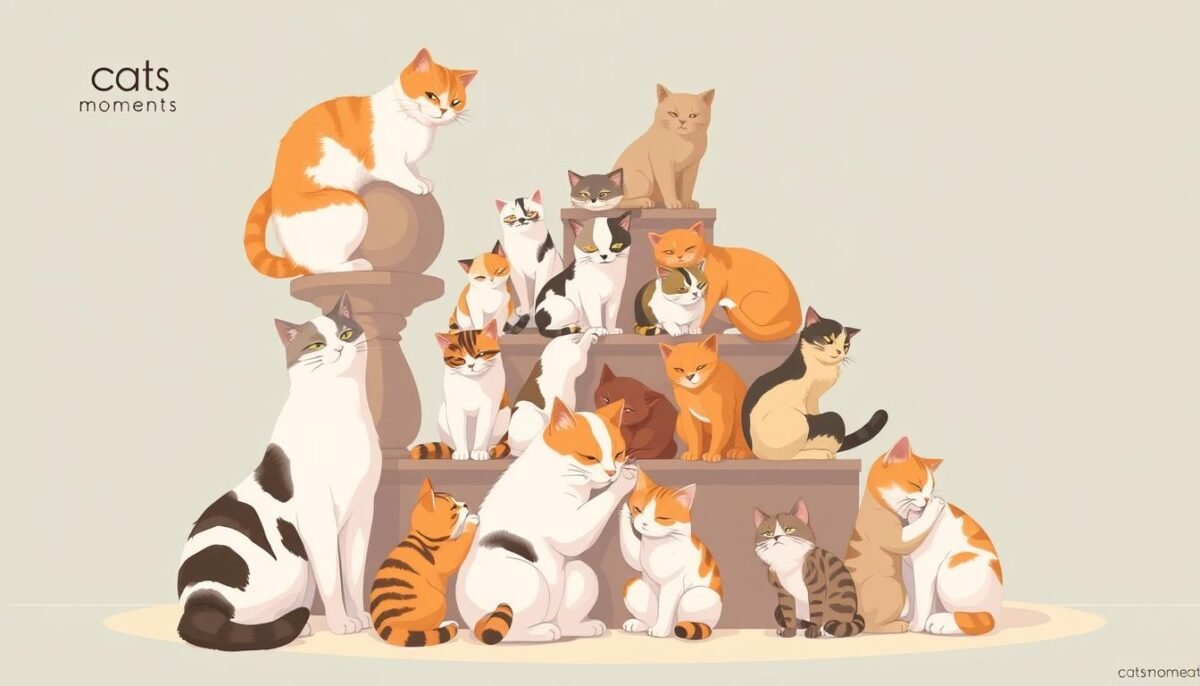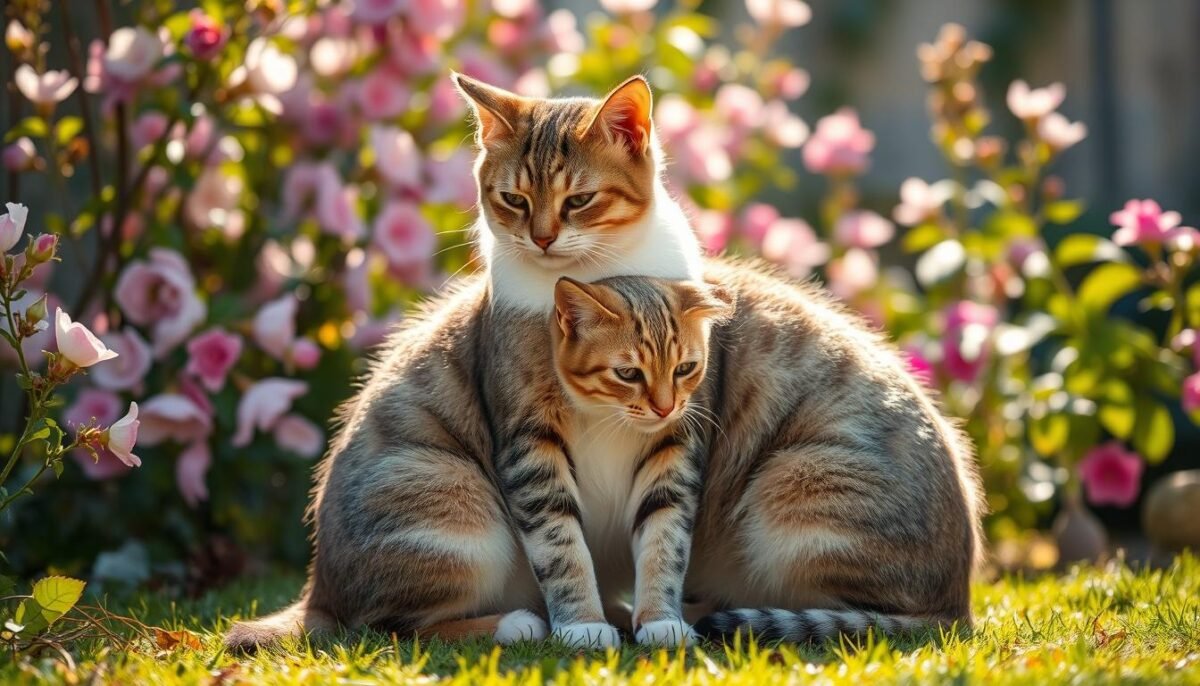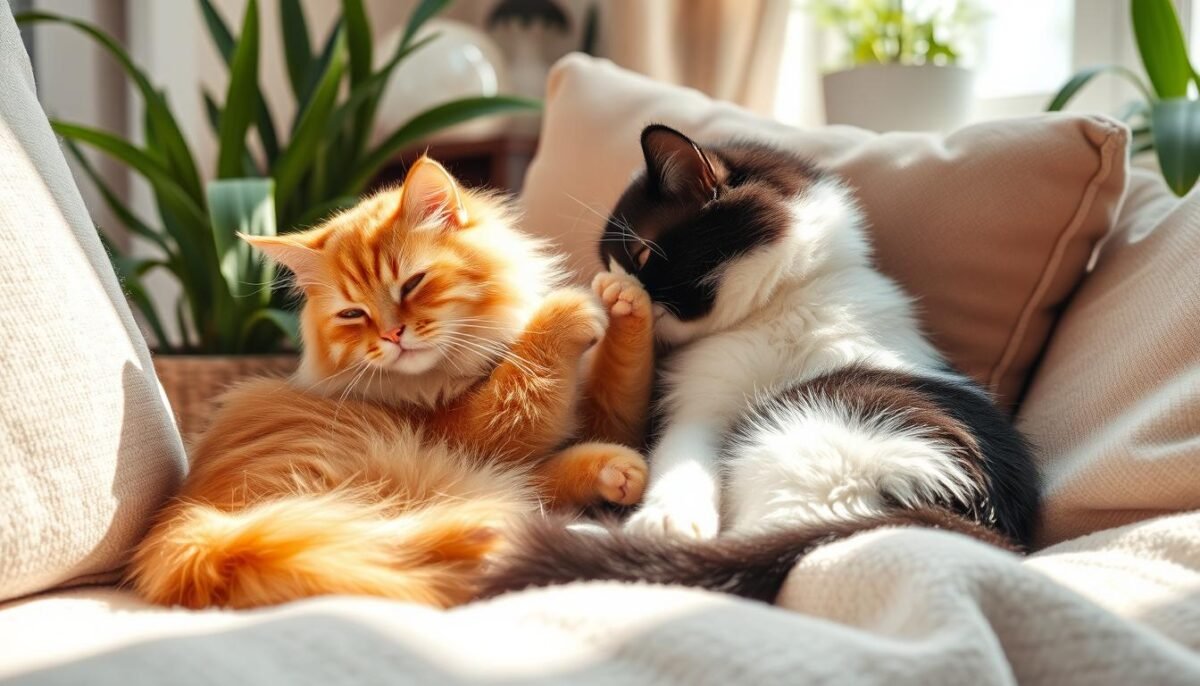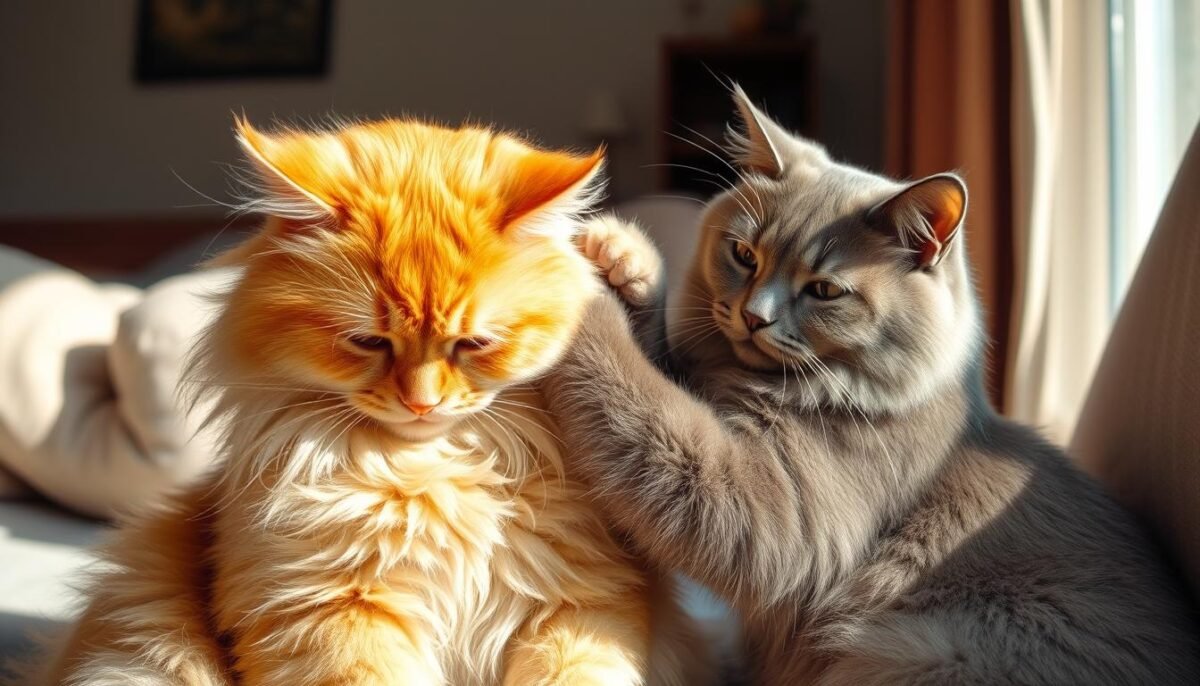Ralph Waldo Emerson once said, “The purpose of life is not to be happy. It is to be useful, to be honorable, to be compassionate, to have it make some difference that you have lived and lived well.” This idea is not just about cats grooming each other. It shows how all living beings, including cats, try to make a difference by bonding and helping their communities.
In the world of cat behavior, grooming each other is very important. It shows how cats connect, show love, and keep their social groups balanced. By understanding why cats groom each other, we can see how much they value their relationships and the important role they play in each other’s lives.
Key Takeaways:
- Grooming is a crucial aspect of feline social bonding and communication.
- Cats groom each other to maintain hygiene, provide emotional comfort, and reinforce social hierarchies.
- The science behind cat grooming involves pheromones, biological benefits, and insights into their social structures.
- Understanding the nuances of grooming behavior can help us better appreciate the depth of our cats’ relationships.
- Encouraging grooming among our feline companions can foster stronger bonds and a deeper understanding of their social nature.
Understanding Cat Grooming Behavior
Many of us have seen our cats groom themselves. But what is cat grooming, and why do cats spend so much time on it? Let’s explore the world of cat grooming behavior and look at social and solitary grooming.
What is Cat Grooming?
Cat grooming is when cats clean themselves. They lick their fur, paws, and body to get rid of dirt and oil. It also helps them stay warm and keeps their fur shiny.
Social vs. Solitary Grooming
- Solitary Grooming: Cats groom themselves a lot. They spend hours each day doing this. It keeps their fur and skin healthy and prevents skin problems.
- Social Grooming: Cats also groom each other. This is called social grooming. It helps them bond and live in harmony with each other.
Understanding cat grooming is important. It shows us how cats are social and emotional. Knowing about solitary and social grooming helps us care for and connect with our cats better.
The Importance of Social Bonds in Felines
Feline social bonding is a fascinating aspect of cat behavior. It shows how grooming strengthens relationships among our feline friends. Cats groom each other to stay clean and to communicate and build community.
How Grooming Strengthens Relationships
When cats groom each other, they strengthen their bonds. This act releases hormones like oxytocin, which build trust and affection. It helps cats form and keep strong social ties, creating a harmonious cat community.
The Role of Grooming in Cat Communities
Grooming is key in cat communities too. Cats that groom each other form closer social groups. They feel more secure and comfortable, which reduces stress and anxiety.
| Benefit | Description |
|---|---|
| Strengthening Bonds | Grooming helps cats establish and maintain strong social connections, fostering a sense of trust and affection. |
| Community Building | Mutual grooming behaviors contribute to the formation of cohesive and harmonious cat communities. |
| Stress Reduction | The social support and comfort provided by grooming can help cats feel more secure and less stressed. |
“Grooming is not just a way for cats to keep themselves clean; it’s also a crucial means of communication and social bonding within their communities.”
Understanding feline social bonding and cat communication through grooming helps us appreciate their social lives. It also helps us build stronger connections with them.
Types of Grooming: Mutual vs. Solo
Cats have two ways of grooming: mutual grooming and solo grooming. Knowing the difference helps us understand their social lives and happiness. It shows how they care for themselves and each other.
What is Mutual Grooming?
Mutual grooming, or cat allogrooming, is when cats groom each other. They do this to get closer, show love, and feel part of the group. It’s common among friends or family cats.
When Do Cats Groom Themselves?
Solo grooming is when cats groom themselves. They use their tongue, paws, and teeth to stay clean. It’s important for their health and keeps them looking good.
Learning about mutual and solo grooming helps us appreciate our cats more. It shows us how to make their lives better and support their natural behaviors.
“Mutual grooming is a key component of social bonding in cat communities, fostering trust, affection, and a sense of belonging.”
| Mutual Grooming | Solo Grooming |
|---|---|
| Strengthens social bonds | Maintains personal hygiene |
| Expresses affection and trust | Helps remove dirt and excess fur |
| Reinforces the cat’s place in the community | Influenced by age, mood, and environment |
Reasons Why Cats Groom Each Other
Cats groom each other for many reasons. This behavior is key to their health and happiness. It shows us how cats care for each other and keep themselves clean.
Maintaining Hygiene and Health
Cats groom to stay clean and healthy. It removes dirt and keeps their fur in good shape. This helps prevent skin problems and keeps them feeling fresh.
By grooming, cats also check for injuries. This way, they can take care of each other’s health. It’s a way to keep their cat hygiene through grooming in check.
Emotional Comfort and Stress Relief
Grooming is also a way for cats to relax. The gentle motion of grooming is calming. It helps them feel secure and stress-free.
This behavior strengthens their bonds. It shows how important grooming is for their emotional well-being. By understanding why do cats groom each other, we see the deep connections in their world.
The Science Behind Cat Grooming
Exploring cat communication through grooming reveals a world of science. It shows how pheromones and grooming benefit cats. Let’s dive into the science behind this vital cat behavior.
The Role of Pheromones
Cats use pheromones to talk to each other. These chemical signals are key in cat communication through grooming. They share mood, status, and territory info. Grooming releases these pheromones, helping cats connect and bond.
Biological Benefits of Grooming
Grooming is more than just making cats look good. It keeps their coat clean and healthy. It removes dirt and fur, keeping them warm and safe from bacteria. Grooming also makes cats feel good, reducing stress.
Learning about cat communication through grooming and cat grooming behavior is enlightening. It shows us the complex world of cats. This knowledge helps us care for them better.
Grooming Hierarchies and Social Structures
Exploring the social life of cats shows how grooming helps create cat hierarchies and builds feline social bonding. Grooming is key in showing who’s in charge and who’s not. It shapes the social order of a group.
Understanding Dominance and Submission
In homes with more than one cat, grooming is a way to show who’s boss. The top cat starts grooming others, while the lower cats let them. This grooming shows who’s in charge and makes the group stronger.
This behavior is linked to social hierarchy. It helps cats get along better and feel part of the group.
The Impact of Age and Experience
- Older, more experienced cats often lead and groom others to keep their spot.
- Young cats and kittens groom elders to learn and find their place.
- How often and how long cats groom each other tells us about their social standing.
Learning about grooming in cats helps us understand their complex social lives. It shows how they communicate and form bonds in a multi-cat home.

“Grooming is not just about keeping clean; it’s a vital component of a cat’s social interactions and hierarchical communication.”
Grooming and Cat Behavior Posture
Learning about the body language cats show when they groom each other is key. Cat communication through grooming and cat bonding through grooming are vital. They tell us a lot about their social lives and health.
Body Language During Grooming
Cats groom each other in many ways, showing their feelings and relationship. When they move slowly and calmly, it means they’re happy and safe together.
- Cats may lean into each other, showing trust and love.
- Kneading with their paws and purring shows they’re happy and close.
- They often groom each other in turns, showing they care for each other.
Signs of Positive Interaction
Watching cats groom each other can show how close they are. When they groom together, it’s a sign of a strong bond.
- Looking into each other’s eyes and relaxed faces show trust.
- Grooming together in sync shows they’re connected and understand each other.
- Slow, rhythmic grooming is a sign of a fun and peaceful time for both.
Understanding cat communication through grooming helps us see their social lives better. It shows how important these moments are for their happiness and health.
Recognizing Grooming as Communication
Cat communication is fascinating and often overlooked. Grooming is key to understanding feline interactions. It’s not just about cleanliness; it’s a way cats bond and communicate.
Vocalizations Associated with Grooming
When cats groom each other, they make sounds that show their feelings and relationships. Purring means they’re happy, trust each other, and have a strong bond. But hissing or growling can mean they’re uncomfortable or have a power issue.
Implications of Grooming for Cat Relationships
Grooming shows a cat’s social structure and who’s in charge. Mutual grooming means they have a strong, equal relationship. But one cat grooming another can show a dominant or mentor role.
Watching how cats groom each other helps us understand their cat communication through grooming and feline social bonding. This knowledge helps us connect better with our cats.

“Grooming is not just a physical act, but a means of expressing social bonds and hierarchies within a cat community.”
The Differences Between Domestic and Wild Cats
Domestic and wild cats show different ways of grooming and social bonding. Knowing these differences helps us understand our pets better.
Grooming Behaviors in Wild Cat Species
Wild cats like lions and tigers groom to keep their coats clean. They use their tongues to remove dirt and fur. But they don’t groom each other like domestic cats do.
Adaptations of Domestic Cats
Domestic cats focus more on grooming each other. This helps them bond and feel close. They groom to show trust and belonging, thanks to living in smaller spaces.
| Characteristic | Wild Cats | Domestic Cats |
|---|---|---|
| Grooming Behavior | Primarily self-grooming for hygiene and coat maintenance | Emphasis on mutual grooming for social bonding and strengthening relationships |
| Social Interactions | Less frequent and often more hierarchical | More frequent and focused on strengthening social ties |
| Living Conditions | Vast, open environments | Confined, indoor living spaces |
Understanding the grooming habits of domestic and wild cats helps us value our pets’ unique traits. It shows how important grooming is for their social bonds.
How to Encourage Grooming Among Our Cats
Cats naturally groom themselves and each other. As pet owners, we can help this social behavior. By making a calm space and helping them meet, we can boost their grooming and bond.
Creating a Stress-Free Environment
Cats love a peaceful, safe place. Give them lots of space, like their own beds and places to climb. Keep it quiet and steady to make them feel calm. When they’re relaxed, they’re more likely to groom each other.
Introducing Cats to Each Other
Introducing cats to each other is key for good interactions. Start slow, letting them get used to each other’s smells and looks. Make sure they have their own food and toys to avoid fights. With patience, they might start grooming each other, deepening their friendship.

Every cat is different, so what works for one might not work for another. By making a caring space and encouraging good interactions, we help our cats grow closer through grooming.
Conclusion: The Bonds We Share with Our Cats
Grooming is more than keeping our cats clean. It shows the deep social bonds and relationships in the cat world. This includes the special bond we have with our cats. By learning about grooming in feline social bonding, we can understand our cats better. This helps us create a caring space for them to grow.
Emphasizing Bonding Through Grooming
When cats groom each other, it shows their strong social ties. This grooming is not just for cleanliness. It’s a sign of trust, love, and belonging in the cat world. By joining in, we can make our bond with our cats even stronger.
Appreciating our Cats’ Social Nature
Cats are not always seen as social animals. But they have complex emotional and behavioral needs. Learning about grooming helps us see our cats’ rich lives. By supporting their social and emotional needs, we build a better relationship with them.
FAQ
What is cat grooming?
Cat grooming is when cats clean themselves. It’s a daily routine for them. It keeps their fur, skin, and claws healthy.
Why do cats groom each other?
Cats groom each other to bond and show respect. It’s a way to communicate and reduce stress. It also keeps them healthy.
What are the different types of cat grooming?
Cats groom themselves and each other. Self-grooming keeps their coat clean. Social grooming, or allogrooming, strengthens their bonds.
How does grooming contribute to feline social bonds?
Grooming helps cats form and keep social bonds. It lets them communicate and show affection. Mutual grooming is especially important for their emotional well-being.
What are the biological and emotional benefits of cats grooming each other?
Grooming keeps cats clean and healthy. It also makes them feel comfortable and secure. It’s a way for them to bond and relax together.
How do cats establish dominance and hierarchy through grooming?
Grooming helps cats show who’s in charge. Dominant cats groom others to assert their status. Submissive cats groom to show respect. It shows the social order in a group.
What is the role of pheromones in cat grooming?
Pheromones are important in cat grooming. Cats have scent glands in their cheeks, paws, and head. Grooming transfers these pheromones, helping them communicate and bond.
How can I encourage grooming among my cats?
Create a calm environment for your cats. Make sure they have what they need, like scratching posts. Slowly introducing new cats can also help. This encourages them to groom each other and live in harmony.






